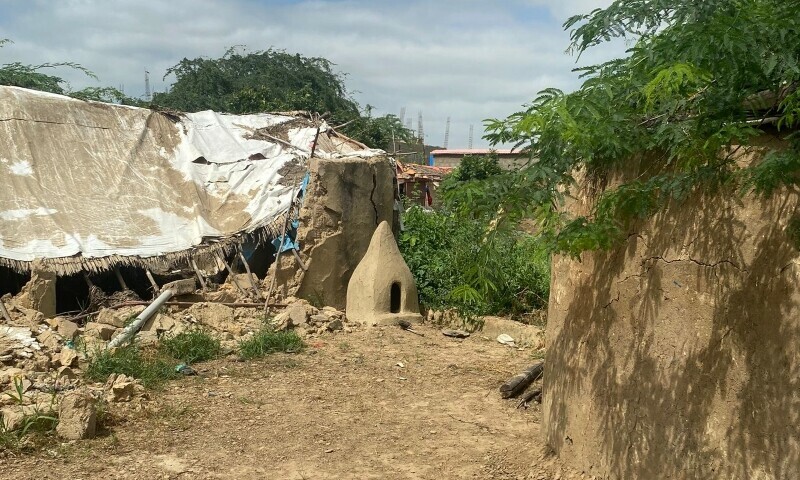At a flood relief camp recently visited by Dawn.com in Karachi’s Surjani, a large body of stagnant water was the first thing one saw upon entering the site which is housing over 1,300 flood-affected men, women, and children from Sindh, Balochistan and even Punjab.
The camp, set up in the Government Degree Boys College in Surjani, was set up by the Sindh government to accommodate internally displaced persons (IDPs) after devastating floods washed away their homes and livelihoods.
The drinking water for the camp, stored in blue tanks, was turbid and looked unfit for consumption. Despite this, the people at the camp directly dipped their water bottles and pans in the containers.

A visit to the washroom was a harrowing sight, with urine and faeces lining the corridors. The toilets hadn’t been cleaned for days, with the sanitation staff saying there was no water available to wash the facility.
Unsurprisingly, the people there are ill.
There is a large number of cases of diarrhoea alongside dengue and malaria. Skin diseases are rampant, with impetigo and scabies common among the inhabitants, especially young children.
Dawn.com went to a medical camp that was organised at the site by the Communicable Disease Control (TB Programme) Director General Health Services Sindh in collaboration with the Medical Microbiology and Infectious Diseases Society of Pakistan (MMIDSP).
Almost 400 people were checked and provided medication for stomach-related ailments, dengue and skin infections. Sputum samples were also collected for suspected TB cases.

The camp in Surjani is similar to others set up to shelter flood victims. These camps serve as breeding grounds for viral infections which the federal and provincial governments are struggling to control.
So how does one deal with a disease outbreak in camps where thousands are being provided temporary shelter?
Dawn.com spoke to infectious disease experts in Pakistan to find out if any low-cost and immediate interventions are possible to help the flood-affected population, where children and the elderly are the most vulnerable to diseases.
The experts recommend making use of the sunshine, controlling mosquitoes, practising good hygiene and getting the community actively involved.
Gastroenteritis has emerged as a major disease at flood camps and in areas where people are returning home after the floodwater has receded.
Commonly referred to as ‘gastro’ in Pakistan, gastroenteritis (infectious diarrhoea) is inflammation of the gastrointestinal tract that involves the stomach and small intestine.
Signs and symptoms include diarrhoea, vomiting, and abdominal pain. Fever, lack of energy, and dehydration may also occur.
Dr Samreen Zaidi, assistant professor and paediatric infectious diseases consultant at the Sindh Infectious Diseases Hospital and Research Centre, said that the simplest method for preventing diarrhoea was to ensure hand-washing, clean drinking water and proper disposal of human waste.
“As long as the source of drinking water is contaminated, stomach infections will occur,” Dr Zaidi said. She stressed that young children must be taught to properly wash their hands with soap after using the toilet.
“The faecal-oral transmission route is severely overlooked on campsites and is contributing to a large number of cases, especially among children. Mothers must be taught basic steps, which include hand-washing, disposal of diapers and washing/boiling bottles.”
Faecal–oral transmission occurs when bacteria or viruses found in the stool of one person (or animal) are ingested by another.
Let the sunshine in
So how does one ensure that clean water for drinking, cooking, and even bathing is available at these camps?
Water purification tablets are relatively expensive and considered the best method to make water fit for consumption, but many are hesitant to use them due to a change in the taste of the water or impotency fears.

Dr Faisal Mehmood, an associate professor of infectious diseases at Aga Khan University and a member of MMIDSP, elaborated on two low-cost interventions that could help prevent gastroenteritis: boiling water and opting for solar disinfection (SODIS).
Though boiling water remains an issue at most campsites, SODIS is a viable and simple option, provided that the water source is low turbidity. The method targets diarrhoea-causing pathogens with solar radiation, specifically UV-A radiation.
The method involves a few simple steps:
- Wash a one or two-litre plastic bottle. The bottle must be clean, transparent, colourless, and all plastic/paper labels must be removed. (It is recommended to wash all bottles before first use).
- Fill the bottle with water. Using a clean cloth or sieve while pouring the water into the bottle is a good idea.
- The bottle is then exposed to direct sunlight for one full day (at least six hours, including noon) on mostly sunny days or two days when the sky is cloudy. The method is ineffective on rainy days.
- The treated water is stored until consumption in order to avoid re-contamination.
According to the US Centers for Disease Control (CDC), over two million people in 28 developing countries use the method for their daily drinking needs.
In its guidelines, the CDC says the method has a “proven reduction of viruses, bacteria, and protozoa in water” as well as a reduction of diarrheal disease incidence. It goes on to add that “recontamination is low because water is served and stored in the small narrow-necked bottles”.
Nip in the bud
In response to a question about whether a “dengue emergency” should be declared in the country and the strategy which must be followed to drastically reduce dengue and malaria cases, the MMIDSP said mosquito control is of paramount importance.
The association — which represents infectious disease doctors, microbiologists and allied professionals in the country — said controlling mosquitoes at camps as well as in densely populated cities is crucial.

“Mosquitoes have become resistant to commonly used insecticides; fogging is the least effective strategy. Use of cost-effective, environmentally friendly, locally-produced larvicide would be an effective strategy in blocking the propagation of mosquitoes and will help with immediate control of both dengue and malaria,” said Dr Bushra Jamil, the president of MMIDSP and a professor at AKU.
According to the CDC, a larvicide is a type of insecticide used to control mosquitoes indoors and outdoors around your home. Larvicide works by killing mosquito larvae before they can grow into adults.
Some formulations are activated when ingested by mosquitoes, and some formulations work when they come into contact with the larvae. When used according to product label instructions, larvicides do not harm people, pets, or the environment.
During a mosquito-borne disease outbreak, a toxin produced by the bacteria bacillus thuringiensis subspecies israelensis (Bti) — a key component of larvicide — is used to kill mosquito larvae before they can complete their life cycle. When mosquito, black fly, and fungus gnat larvae consume Bti, they die. Bti does not control biting adult mosquitoes.
Infectious diseases experts said that Bti is most effective when used as part of an integrated mosquito management plan for reducing the number of mosquitoes in an area, with a special focus on source reduction, whereby mosquito breeding sites are destroyed.
A caveat is that larvicides work better in larger bodies of water, like marshes, and would be too much for smaller puddles, doctors volunteering at the camp said, but they would certainly work for the large body of water near the camp in Surjani and in the flooded areas where relief camps are.
Because mosquito repellents in liquid and coil form are out of reach for the majority of flood-affected people, Dr Zaidi suggests that children wear long-sleeved shirts and trousers and limit their movement at dawn and dusk.
“The people residing in camps must be provided with mosquito nets. If possible, treated nets (with permethrin) can be used, which offer better protection,” she added. However, treated nets aren’t easily available and are costly.
The endless itch
Medical staff working at flood camps have all reported scabies and impetigo among the inhabitants, especially children and the elderly with limited mobility.
Scabies is an infestation of the skin by the human itch mite. The microscopic scabies mite burrows into the upper layer of the skin where it lives and lays its eggs. Intense itching and a pimple-like skin rash are the most common symptoms of scabies.
For scabies, Dr Zaidi recommends airing laundry and bedding in the sunlight daily. “Camp supervisors and volunteers have to mobilise the community and urge them to make the most of sunlight,” she stressed.
“Keep bedding in the sunlight as it kills scabies mites. You don’t need hi-fi stuff. These little interventions help avert bigger problems,” she added.
Impetigo is a common and highly contagious skin infection that mainly affects infants and young children. It usually appears as reddish sores on the face, especially around the nose and mouth, and on the hands and feet. The sores burst and develop honey-coloured crusts over the course of a week.
Impetigo is treated with antibiotics, but it can be prevented by maintaining good hygiene. Dr Zaidi said it’s important people bathe properly with soap and water, avoid scratching, wash clothes, towels and bedsheets with hot water and dry in the sunlight.
The health experts stressed that without community engagement, these outbreaks will continue to happen and lead to unnecessary deaths.
“Language barrier is a major issue that must be looked into. The camp management and local volunteers must make an effort to explain these guidelines to the flood-affected, especially the women and children. This coordination is important and goes a long way. You can have the best public health experts on board, but as long as you don’t involve the community and give them respect and allow a sense of ownership, things will not change,” the doctors added.



































